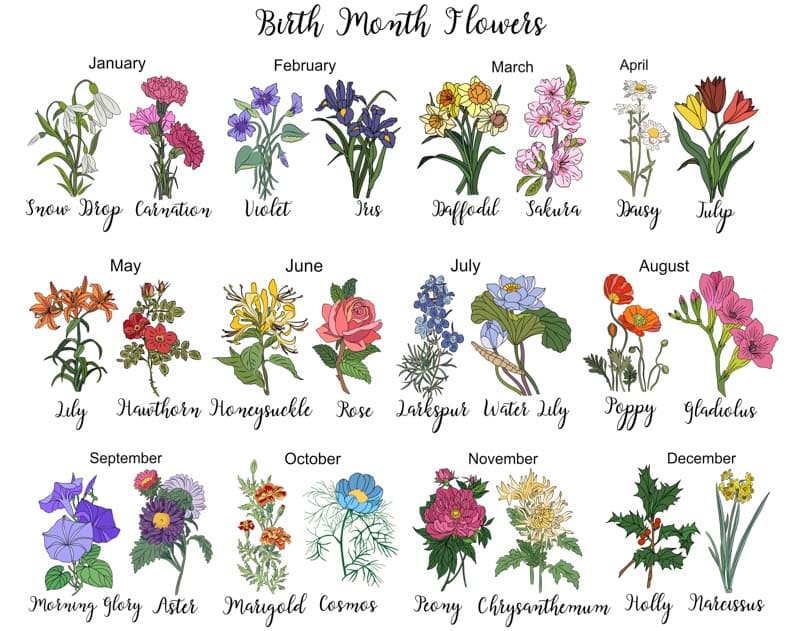Flowers have always been more than just a source of beauty; they carry deep meanings and are often linked to various aspects of human life. One such aspect is the concept of birth flowers, where each month is associated with a particular flower, symbolizing the characteristics, emotions, and virtues of individuals born in that month. Understanding the symbolism of your birth flower can provide insight into your personality and offer a deeper connection to the natural world.
January: Carnation and Snowdrop
January’s birth flowers are the carnation and snowdrop. Carnations, often referred to as “flowers of the gods,” are known for their ruffled appearance and sweet fragrance. They symbolize admiration, love, and distinction. The snowdrop, a delicate white flower that blooms in winter, represents hope and rebirth. Together, these flowers embody the resilience and determination often associated with those born in January.
February: Violet and Primrose
February’s birth flowers are the violet and primrose. Violets are small, vibrant flowers that signify loyalty, modesty, and faithfulness. They are often linked to the idea of everlasting love. The primrose, on the other hand, symbolizes young love and the sense of belonging. These flowers together paint a picture of those born in February as loyal, loving, and deeply connected to others.
March: Daffodil
The daffodil is the birth flower for March. Known for its bright yellow petals, the daffodil symbolizes new beginnings, renewal, and the coming of spring. It represents optimism and joy, qualities that are often associate with people born in March. The daffodil’s vibrant color and cheerful appearance make it a fitting symbol for the hopeful and positive nature of March-born individuals.
April: Daisy and Sweet Pea
April’s birth flowers are the daisy and sweet pea. The daisy, with its simple yet elegant appearance, symbolizes purity, innocence, and true love. It also represents new beginnings and the joy of life. The sweet pea, known for its delicate fragrance, symbolizes blissful pleasure and gratitude. Together, these flowers embody the carefree and joyful spirit often seen in those born in April.
May: Lily of the Valley and Hawthorn
The birth flowers for May are the lily of the valley and hawthorn. The lily of the valley, with its small, bell-shaped flowers, symbolizes sweetness, humility, and the return of happiness. It is often associate with motherhood and nurturing qualities. The hawthorn, a flowering shrub, symbolizes hope and supreme happiness. These flowers together represent the gentle and nurturing nature of those born in May.
June: Rose and Honeysuckle
June’s birth flowers are the rose and honeysuckle. The rose, often regarded as the queen of flowers, symbolizes love, passion, and beauty. Each color of the rose carries its own meaning, from the deep love represented by red roses to the purity symbolized by white roses. The honeysuckle, with its sweet scent and vibrant colors, symbolizes the bonds of love. Together, these flowers represent the deep emotional connections and passionate nature of June-born individuals.
July: Larkspur and Water Lily
The birth flowers for July are the larkspur and water lily. The larkspur, with its tall spikes of flowers, symbolizes lightness, levity, and an open heart. It is often associate with strong bonds of love. The water lily, which blooms in still waters, symbolizes purity of heart and enlightenment. Together, these flowers represent the nurturing and compassionate nature of those born in July.
August: Gladiolus and Poppy
August’s birth flowers are the gladiolus and poppy. The gladiolus, with its tall, sword-like stems, symbolizes strength, integrity, and moral character. It is often associate with the idea of remembering loved ones. The poppy, known for its vibrant red color, symbolizes remembrance and consolation. These flowers together represent the strength and resilience often seen in those born in August.
September: Aster and Morning Glory
The birth flowers for September are the aster and morning glory. The aster, with its star-shaped flowers, symbolizes love, wisdom, and faith. It is often associate with patience and elegance. The morning glory, which blooms early in the day, symbolizes affection and the fleeting nature of life. Together, these flowers represent the thoughtful and wise nature of those born in September.
October: Marigold and Cosmos
October’s birth flowers are the marigold and cosmos. The marigold, with its bright orange and yellow petals, symbolizes passion, creativity, and warmth. It is often associate with the idea of eternal love. The cosmos, with its delicate, daisy-like flowers, symbolizes harmony and balance. These flowers together embody the creative and balanced nature of those born in October.
November: Chrysanthemum
The chrysanthemum is the birth flower for November. Known for its large, showy blooms, the chrysanthemum symbolizes joy, optimism, and longevity. It is often associate with the idea of a life well-lived. The chrysanthemum’s vibrant colors and enduring nature make it a fitting symbol for the strong and positive nature of November-born individuals.
December: Holly and Narcissus
December’s birth flowers are the holly and narcissus. The holly, with its spiky leaves and bright red berries, symbolizes protection, joy, and good fortune. It is often associate with the festive spirit of the holiday season. The narcissus, with its delicate white or yellow blooms, symbolizes self-esteem and respect. Together, these flowers represent the joyful and protective nature of those born in December.
Conclusion
Birth flowers are a beautiful and meaningful way to connect with the natural world and gain insight into the characteristics and qualities associated with each month. Whether you resonate with the strength of the gladiolus, the purity of the daisy, or the joy of the chrysanthemum, understanding the symbolism of your birth flower can provide a deeper sense of identity and connection to the world around you. As you explore the hidden meanings behind these flowers, you’ll uncover a rich tapestry of symbolism that has been woven into human culture for centuries.

